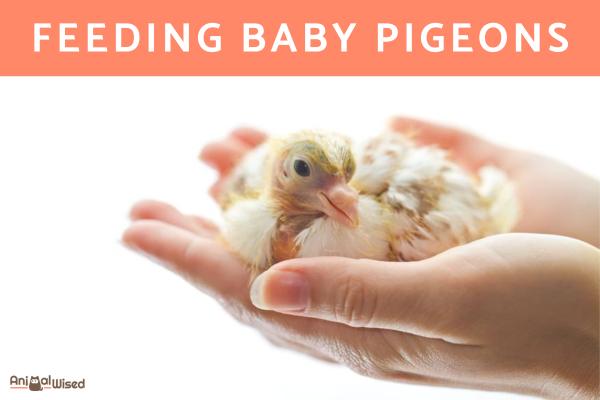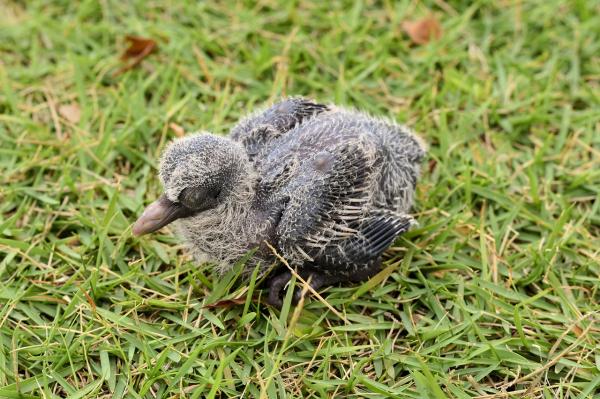
You may need to know what to feed a baby pigeon if you come across one which appears abandoned or injured. However, before we can think about feeding a baby pigeon, there is a certain protocol we need to follow. Such a protocol is to protect the health and wellbeing of both the pigeon and ourselves. Part of this protocol is trying to find an animal rescue center that will accept the pigeon, something not all rescues will do. This is mainly due to the fact there are so many pigeons in urban areas.
At AnimalWised, we explain what to feed a baby pigeon. We also examine what you need to do if you discover a baby pigeon that appears abandoned or in need.
What to do if you find a baby pigeon
Otherwise known as a fledgling, a baby pigeon is usually cared for by both parents during their early stages of life. They live in a nest with the other fledgling pigeons born in the same clutch of eggs. If we see a baby pigeon which is not in their nest, it is usually due to one of two reasons:
- Fledging: after around 25-32 days, baby pigeons will need to leave the nest to fledge. This is the process of leaving the nest and learning to fly. To do this, they need to leap from the nest. These pigeons will have some feathers and be more developed than nestlings. Not all fledglings will be as able at the beginning, meaning some may remain on the ground for a time. They are usually still cared for by their parents, even if we cannot see them immediately.
- Injury: whether they fledge too soon or they have experienced an accident, it is possible a baby pigeon will have fallen from the nest. In this case, the baby pigeon may be unable to return to the nest. Pigeon parents are not usually able to pick them up to return them to the nest, but they may still feed them until they are able to fend for themselves.
For this reason, we should not assume that finding a young fledgling pigeon means they are injured or abandoned. It is perfectly possible they are simply carrying out an important stage of their development. For this reason, the following is the protocol we should follow if we find a baby pigeon:
- Observe: take a look at the area. If there are obvious signs of an accident such as a nest blown away, then the fledgling or nestling will be in trouble. In these cases, the baby bird will need help, especially if there are obvious signs of injury. If there are no signs of injury and the baby pigeon doesn't seem to be in danger, then observe for the parents. After a while, you will likely see adult pigeons tending to the bird.
- Return to the nest: if you are able to see the nest and know the baby pigeon does not have injuries, you should pick them up and return them to the nest. You should do so wearing gloves because it is possible the bird is carrying disease.
- Find a wildlife rehabilitator: a fledging that is trying to fly will have developed body with feathers. You may see them walking around flapping their wings. This does not mean they are in danger, but are simply trying to fly. However, if the bird has a broken wing or has other signs of injury, you will need to contact your local wildlife service. They are best equipped and experienced to treat the injured baby pigeon.
Unfortunately, not all wildlife rehabilitation services will accept pigeons. This is usually a resource issue. If you live in the USA or the UK, you will know that pigeons and doves are some of the most common bird species. For this reason, many wildlife rehabilitation centers will prioritize other animal species and will not accept pigeons for rehabilitation.
Other options may be available depending on where you live. For example, the UK has charities such as the RSPCA which will be able to advise on what to do with an injured bird. Other local animal authorities may be able to provide care for an injured bird.
This guide on what to feed a baby pigeon will cater to all different types of pigeons.
Caring for baby pigeons
If a baby pigeon is abandoned, cannot be returned to the nest or will not be accepted by a wildlife rehabilitation immediately, only then should you provide direct care. This is a last resort as it is always better that animals be cared for by a professional as soon as possible.
Pigeons are altricial animals, meaning they cannot care for themselves immediately after they are born. They require their parents to provide for all of their needs. This involves feeding, but also security and protection. Pigeons do this by providing a nest where the nestlings can be kept warm and better protected from predation. We will need to provide this care for some time.
We cannot care for a baby pigeon for an extended period of time. The reason for this is because pigeons need other birds to teach them vital lessons which allow them to survive. It is for this reason we will need to eventually ensure they are brought to a rehabilitation center. We may not need to do this with an adult pigeon as they will already know these lessons.
Although this guide is in reference to finding feral pigeons, it is possible to keep pigeons as pets. You will not likely find a pet baby pigeon when outside, but you will need to check for tags with adult pigeons.

Where to house a baby pigeon
Before they lay eggs, the pigeons will create a nest. This is a warm space to protect the eggs and then the nestlings once they hatch. We will need to replicate this nest. The best way to do this is to get a sufficiently large cardboard box. A shoebox is ideal. We can then put clean newspaper or straw to use as a substrate a replicate the nest design.
However, the bird will need to stay on something solid. A clean soft cloth is a good option. Doing so will prevent the bird from entangling their legs and causing themselves harm. We can also mold it into a bowl shape which will better mimic the pigeon's nest. These will help the pigeon to grow in the correct position and prevent deformation. Under no circumstances should cat litter be used as a substrate for the baby pigeon.
The box should be placed in a quiet place in the home. Avoid direct sunlight, drafts and very strong heat sources, such as a radiator. We must offer them some heat, so we can place a hot water bottle with warm water next to the box (not in it).
What to feed a newborn pigeon
Adult pigeons are birds that feed on seeds, arthropods and fruit. When caring for young, adult pigeons will eat their own food which allows them to produce a substance known as crop milk or pigeon milk. It is this substance which they use to feed the young squabs (baby chicks).
Pigeons are not mammals, so they do not produce milk through lactation. Pigeon milk is a substance which is secreted by the crop, an anatomical structure found in the alimentary tract of the pigeon. This substances contains protein and fat, allowing the baby pigeons to mee their nutritional needs. It also contains antioxidants, bacteria and other substances which help bolster the pigeon's immune system.
We cannot produce crop milk for pigeons ourselves. It is too complicated a substance to recreate at home. However, we can purchase pigeon crop milk from certain specialized pet stores or from the Internet. Unfortunately, this may take too long to be delivered. This is another reason why it is imperative we find a suitable rehabilitation center for the bird.
If we do find crop milk, we will need to thin it out during the first 10 days of life. We should provide it warm, not hot. After the first 10 days of life, it can be a little thicker, but not stodgy.
In an emergency, we can feed the baby pigeon very thing oat porridge which has been cooked until it is very soft. This should also be served warm. It is not ideal, but it may work for a day or two until a better option is found.
Once the pigeon is old enough, they will be able to transition from crop milk to solid seed. This can be fed to the bird by placing the seed in a straw and inserting this into the mouth of the bird. We cannot do this with baby pigeons as they will choke on solid food.

How to feed newborn pigeons
In nature, the pigeon squabs insert their beaks into one of their parents' mouths. The parent then regurgitates the pigeon milk from the crop. We will need to find a way to mimic this behavior. This can be done in one of two ways:
- Syringe: we introduce the warm porridge into the needleless syringe, ensuring we do not have any air in the syringe. We then introduce the end of the syringe into the beak and direct it towards their crop, which is slightly to the right of their throat. This method is not for beginners as it can seriously harm the pigeon.
- Baby bottle: we put the porridge in a baby bottle and cut the tip of the teat. We introduce the baby pigeon's beak into the cut teat and they can feed. Once they have eaten, we must clean the beak and nostrils.
To understand how much to feed a baby pigeon, we need to check their crop. Place one or two fingers against the crop and ensure there is some food inside. We should not overfeed them as they can suffer serious damage. We must let the crop empty completely every 24 hours.
If we notice the crop has not emptied itself after 24 hours, we may find ourselves facing a crop stasis. This occurs when the food has stagnated and does not continue its route through the digestive system. This can happen if we feed the pigeon food that is too cold, if the animal has a tumor in the proventriculus (part of the stomach) or if they have a fungal infection. In this situation, we must go to a veterinarian.
Below, you can see an alternative method of using a syringe to feed a baby pigeon:
If you want to read similar articles to What to Feed a Baby Pigeon, we recommend you visit our Extra care category.